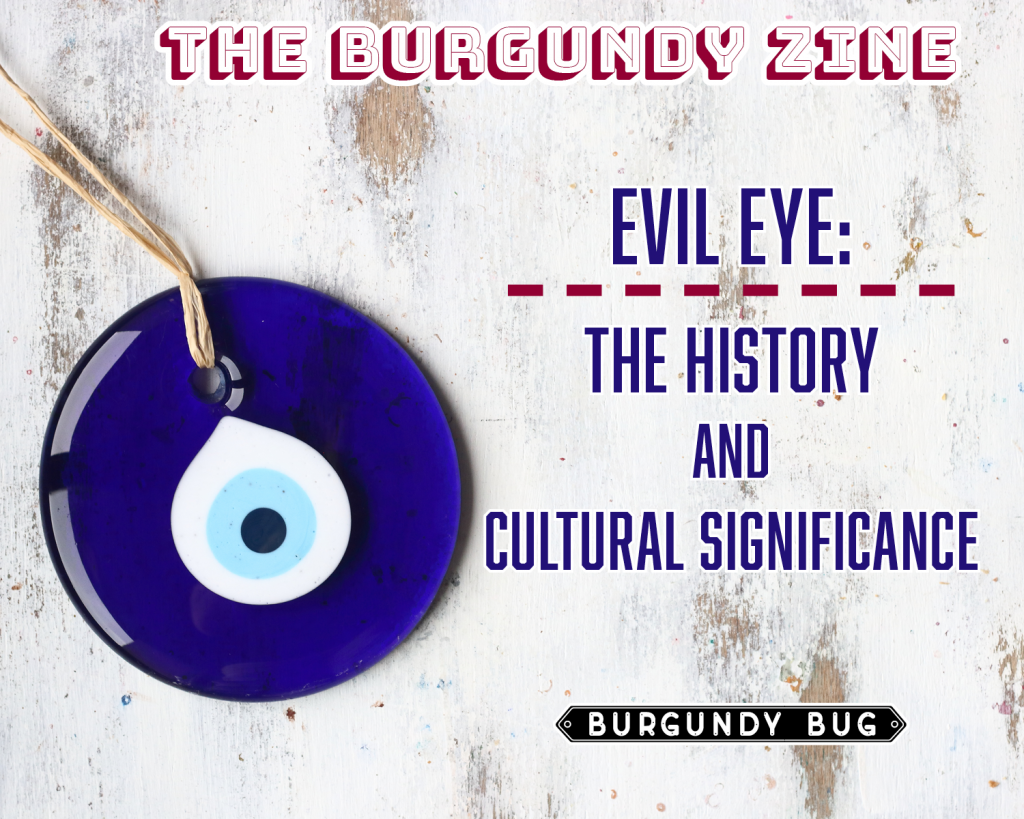November 15, 2019
Evil Eye: The History and Cultural Significance

By: burgundy bug
Evil Eye: The History and Cultural Significance
Source: The Burgundy Zine
A piercing blue gaze meets yours from the beads of a bracelet, pendant of a necklace, or key chain danging from a waist.
This symbol, the “evil eye,” can be traced back to 5,000-year-old Mesopotamian tablets and continues to prevail in modern fashion, according to a 2017 Indian Journal of Scientific Research study.
Today, many cultures still use it as a form of protection from envy – why? How did a blue eye translate into a protective symbol against a timeless, universal superstition about envy?
What is Envy?
“Envy – noun:
Oxford Dictionary definition of “envy” | Lexico
A feeling of discontented or resentful longing aroused by someone else’s possessions, qualities, or luck.”
Envy is a multi-layered emotion that arises from comparison and a feeling of inequity, states a 2013 Culture & Psychology study. It can wield powerful, emotional responses of verbal or physical aggression and hostility.
Thus, ancient cultures recognized envy as a threat early on and began devising methods of protection from it.
Envy as a Disease
In many ways, envy was comparable to a disease in early-modern era civilizations, as described in a 2017 Wellcome Open Research article.
“Envy conveyed a horrifying image of debility and physical torment that was most akin to disease,” the article says. “For instance, Robert Burton in his famous textbook on melancholy followed on this traditional definition of envy by referring to the envious as ‘a living anatomy’, ‘a skeleton’, ‘a pale and leane carcasse.’”
The earliest literary depictions of envy rise from Ovid’s “Metamorphoses,” in which envy is characterized as “sallow cheeks,” “shrunk body,” “decayed teeth,” and a “venom-coated tongue.”
Envy as a Threat
“A much more conventional theory of the evil eye argues that it is basically concerned with envy, specifically the fear that someone else’s envy of one’s own good fortune may bring about misfortune.”
“The Evil Eye: Forms and Dynamics of a Universal Superstition” by Helmut Shoeck | “The Evil Eye: A Casebook” by Alan Dundes
“Fear of the Evil Eye is man’s oldest and most universal superstition,” writes Helmut Shoeck in ‘The Evil Eye: Forms and Dynamics of a Universal Superstition.’ “It is probably our most destructive one too, and it derives from elementary facts of human biological and social existence.”
In his article, Shoeck further details the psychology behind the fear of the evil eye and preventive measures individuals take against it, including the amulets worn across various cultures.
Shoeck cites a scholar’s analysis of over 2,000 evil eye amulets, which all shared basic features: they were found on doors, bedrooms, and barns. More often than not, the evil eyes were blue, a color that is seen as “protective” in many cultures. But in Latin America, red ribbons were worn by children for protection.
“In its most fundamental shape, the hostile stare is considered as a look given to cause damage, enduring, or some type of misfortune on those that it is provided reason to feel ambiguous about,” states the 2017 Indian Journal of Scientific Research study. “It is a look which plainly expresses that one plans for something awful to happen to the protest of one’s concentration, either out of desire or immaculate noxiousness.”
Belief in the evil eye exists across all continents, from the Middle East through Asia all the way to Central America, according to the study.
Historically, envy has been seen as such a threat, Classic Greece, Ancient Rome, and Islamic culture hold excessive praise as a form of the evil eye.
“Therefore, instead of praising an adorable child, one is supposed to say that ‘God has willed’ the child’s good lucks, or risk endangering the youth,” the study explains.
Culturally, the evil eye from a human’s glare is believed to bring forth misfortune ranging from minor mishaps to injury, sickness, and in the most extreme cases, death.
“The best way to deal with the evil eye is to avoid it in the first place”
A STUDY OF THE EVIL EYE PHENOMENON AND HOW IT IS TRANSLATED INTO MODERN FASHION, TEXTILES, AND ACCESSORIES | Indian Journal of Scientific Research
Evil Eye Amulets
Glass evil eye amulets dangling from a tree
Source: Adobe Stock
The most recognizable depiction of the evil eye is a circular, blue amulet with a blue eye in its center. Sometimes the evil eye is depicted as an ellipse, it may have eyelashes, and it can be red instead of blue.
In other cultures, the Hamsa Hand or “Hand of God” is used to ward off the evil eyes. Additionally, it’s not uncommon for a Hamsa Hands to contain an eye on its palm or dangling from its fingers.
The Modern-Day Evil Eye
Today, the evil eye is worn on beaded bracelets, necklaces, keychains, clothing, and handbags. The evil eye has been sported by the likes of Jennifer Anniston, Kim Kardashian, and Miley Cyrus, among many other celebrities.
Therefore, the evil eye is not just a fashion statement: it’s a superstition that has prevailed the test of time, signifying an innate desire to protect one’s self from “the green-eyed monster,” jealousy – or, as the kids may say these days, “the haters.”
Interested in having content featured in an upcoming blog post or issue of The Burgundy Zine? Head on over to the submissions page!
For all other inquiries, please fulfill a contact form.



